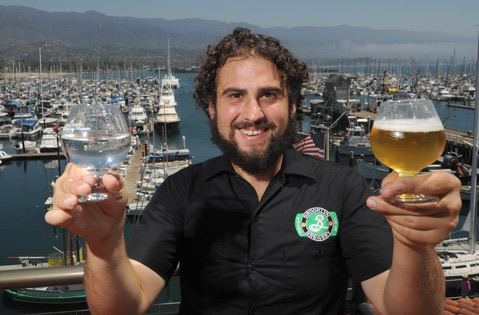That’s Water in Your Beer
Zachary Rosen Hosts Informative Anchors & Ales Event at Santa Barbar

No matter which beer you’re drinking, that’s mostly water in your glass — from 80-95 percent of the recipe depending on the style. As such, the type and quality of water used makes a big difference in a beer’s flavor and mouthfeel. But the clear stuff’s starring role is also responsible for understanding beer’s past, as the drink of choice for seafaring explorers who needed hydration but couldn’t rely on spoiled water or stronger booze, and for learning lessons about the present, as California craft brewers eye conservation measures amid the state’s reservoir-depleting drought.
Beer expert Zachary Rosen will dive into these topics and more on August 16, when 11 brewing companies/collectives will converge to serve more than 20 beers alongside informative exhibits and quality food at the Santa Barbara Maritime Museum during the three-hour Anchors & Ales event. It’s the latest in Rosen’s unending quest to present an educational yet entertaining forum for understanding ale, most recently witnessed during the eclectic Hoptopia event in June at the Carrillo Rec Center.
“For me, this isn’t a single event, but really an extension of my whole body of work,” said Rosen, lamenting that many beer and wine festivals have devolved into places where people get wasted rather than informed. “They’re absolute shit-shows with people getting sloppy drunk. They don’t care about the beer … except for which has the highest alcohol content.”
Instead, Rosen is putting up a series of “pop-up” exhibits around the Maritime Museum, pairing posters and brief presentations with creatively connected craft beers, a format he finds more engaging than a formal lecture. “I like that more intimate interaction,” said Rosen, who will also integrate beer topics into other more permanent museum exhibits, such as discussing glassware in front of the Point Conception Lighthouse lens and having the women’s brewing club Hop Tarts serve beers in front of the upcoming female lighthouse keepers display.
Altogether, Rosen explained, “I want people to learn and use their senses and remember the festival and, quite frankly, not get blackout drunk.” Here’s what to expect:
Ode to IPA: “Beer was basically the sailor’s form of drinking water,” said Rosen, and Englishmen who traveled to India consumed ales that were loaded with extra hops and higher alcohol as preservatives, resulting in today’s wildly popular India Pale Ale, or IPA, style. So as an ode to that maritime history, Dan Reyes of CARP Brewers created an IPA flavored with Ceylon tea for the event, which, said Rosen, “communicates the story of IPA.”
Drinking Dirty Water: Unlike wine or liquor, beer’s unique reliance on water as a main ingredient also involved how the H2O interacts with the other ingredients of hops, barley, and yeast. “Before we knew about water chemistry and how to manipulate it, the historic beer styles evolved around what they had available to them,” said Rosen, who will illustrate this point with Santa Barbara Brewing Company’s “Amigose del Mar,” an ale inspired by the Gose River in Germany, where brewers used salty, brackish water in their brews. So S.B. Brew Co. threw some table salt, seawater, and coriander in the Amigose to copy that effect.
Conserve with Cans: Ballast Point will show off their popular canned beers and compare how they smell and taste related to their bottled versions. Since cans are lighter, explained Rosen, they help save gas and water in their transportation efficiency. And brewers should save as much water as they can, for once brewery cleaning is factored in, some places use as much as 10 barrels of water for every one barrel of finished beer. “That’s a pretty high usage,” said Rosen.
Sipping the Sea: Just for kicks, Rosen also brewed a robust porter with kelp from a UCSB lab. It’s still fermenting, but Rosen hopes it will be like the other kelp- or oyster-shell-infused beers he’s had. “The flavors of the sea in beer usually have a smoky, salty, toasty note to them,” he explained. “It works well with a porter.”
4•1•1
Anchors & Ales is on Saturday, August 16, 5-8 p.m., at the Santa Barbara Maritime Museum (113 Harbor Wy.). Tickets are $35 for museum members and $50 for everyone else until August 8, when the price goes up to $50 and $65. Only 300 tickets will be sold. See sbmm.org.



